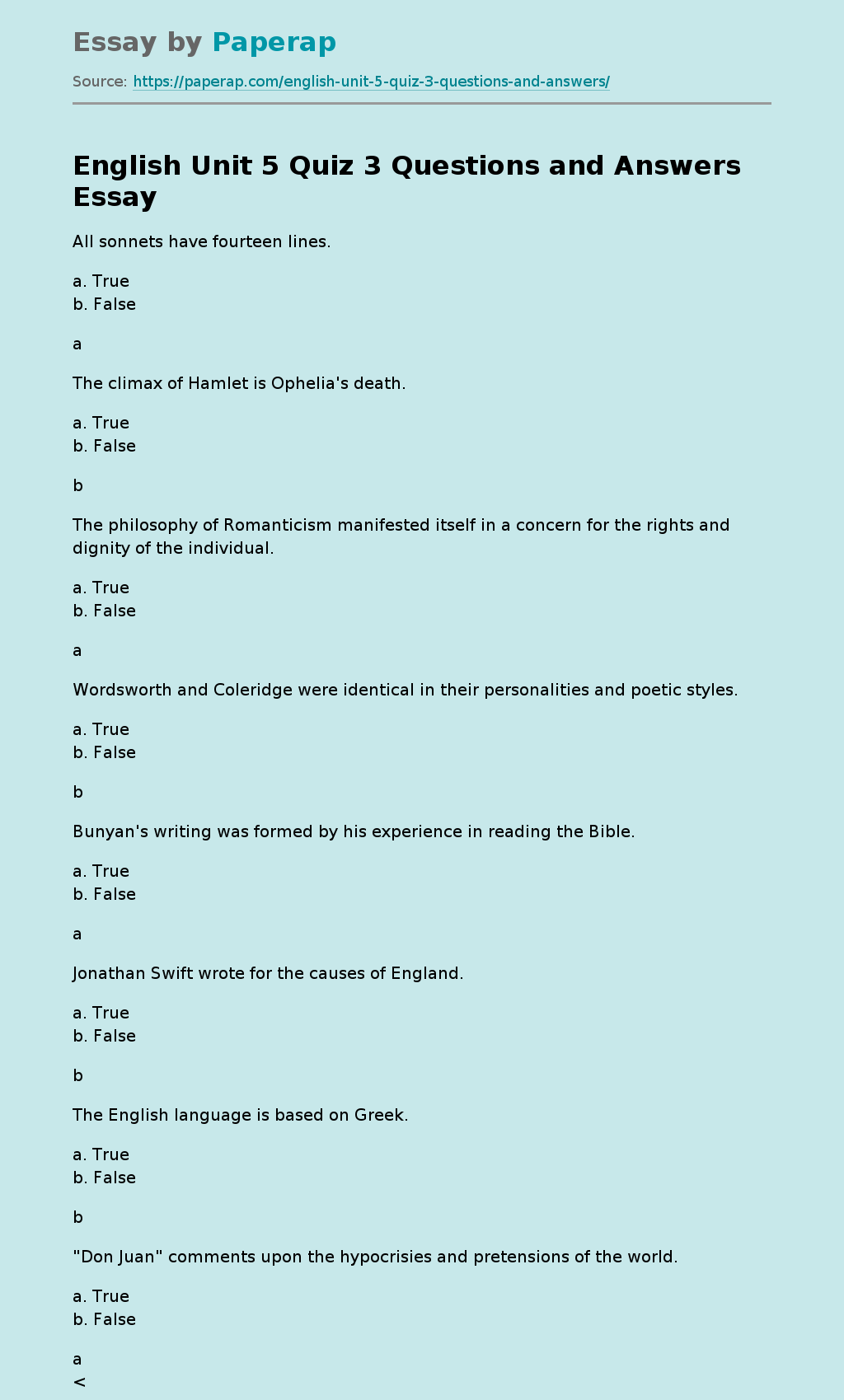English Unit 5 Quiz 3 Questions and Answers
All sonnets have fourteen lines.
a. True
b. False
The climax of Hamlet is Ophelia’s death.
a. True
b. False
The philosophy of Romanticism manifested itself in a concern for the rights and dignity of the individual.
a. True
b. False
Wordsworth and Coleridge were identical in their personalities and poetic styles.
a. True
b. False
Bunyan’s writing was formed by his experience in reading the Bible.
a. True
b. False
Jonathan Swift wrote for the causes of England.
a. True
b. False
The English language is based on Greek.
a. True
b. False
“Don Juan” comments upon the hypocrisies and pretensions of the world.
a. True
b. False
Shelley’s life was contrary to the ideas he explored in his poetry.
a. True
b. False
Chaucer
a. The Canterbury Tales
b. “Kubla Khan”
c. Hamlet
d. “Tintern Abbey”
e. “My Last Duchess”
f. Rasselas
g. “A Modest Proposal”
h. Pilgrim’s Progress
i. Oliver Twist
j. “Crossing the Bar”
Samuel Johnson
a. The Canterbury Tales
b. “Kubla Khan”
c. Hamlet
d. “Tintern Abbey”
e. “My Last Duchess”
f. Rasselas
g. “A Modest Proposal”
h. Pilgrim’s Progress
i. Oliver Twist
j. “Crossing the Bar”
William Shakespeare
a. The Canterbury Tales
b. “Kubla Khan”
c. Hamlet
d. “Tintern Abbey”
e. “My Last Duchess”
f. Rasselas
g. “A Modest Proposal”
h. Pilgrim’s Progress
i. Oliver Twist
j. “Crossing the Bar”
William Wordsworth
a. The Canterbury Tales
b. “Kubla Khan”
c. Hamlet
d. “Tintern Abbey”
e. “My Last Duchess”
f. Rasselas
g. “A Modest Proposal”
h. Pilgrim’s Progress
i. Oliver Twist
j. “Crossing the Bar”
Robert Browning
a. The Canterbury Tales
b. “Kubla Khan”
c. Hamlet
d. “Tintern Abbey”
e. “My Last Duchess”
f. Rasselas
g. “A Modest Proposal”
h. Pilgrim’s Progress
i. Oliver Twist
j. “Crossing the Bar”
Charles Dickens
a. The Canterbury Tales
b. “Kubla Khan”
c. Hamlet
d. “Tintern Abbey”
e. “My Last Duchess”
f. Rasselas
g. “A Modest Proposal”
h. Pilgrim’s Progress
i. Oliver Twist
j. “Crossing the Bar”
Alfred, Lord Tennyson
a. The Canterbury Tales
b. “Kubla Khan”
c. Hamlet
d. “Tintern Abbey”
e. “My Last Duchess”
f. Rasselas
g. “A Modest Proposal”
h. Pilgrim’s Progress
i. Oliver Twist
j. “Crossing the Bar”
Samuel Coleridge
a. The Canterbury Tales
b. “Kubla Khan”
c. Hamlet
d. “Tintern Abbey”
e. “My Last Duchess”
f. Rasselas
g. “A Modest Proposal”
h. Pilgrim’s Progress
i. Oliver Twist
j. “Crossing the Bar”
Jonathan Swift
a. The Canterbury Tales
b. “Kubla Khan”
c. Hamlet
d. “Tintern Abbey”
e. “My Last Duchess”
f. Rasselas
g. “A Modest Proposal”
h. Pilgrim’s Progress
i. Oliver Twist
j. “Crossing the Bar”
John Bunyan
a. The Canterbury Tales
b. “Kubla Khan”
c. Hamlet
d. “Tintern Abbey”
e. “My Last Duchess”
f. Rasselas
g. “A Modest Proposal”
h. Pilgrim’s Progress
i. Oliver Twist
j. “Crossing the Bar”
The exciting force of Hamlet is _____.
a. the ghost’s first appearance to Hamlet
b. Claudius’s explanation of his marriage to Gertrude
c. the death of Polonius
d. Hamlet’s passing up the “perfect” opportunity to kill Claudius
The climax of Hamlet is _____.
a. Polonius’s death
b. the ghost’s first appearance to Hamlet
c. Hamlet’s passing up his best opportunity to kill Claudius
d. the fencing between Laertes and Hamlet
In his poetry, Keats attempted to _____.
a. discuss society’s ills and advocate reform
b. achieve emotional restraint and imaginative discipline
c. resolve conflicts between scientific theories and religious beliefs
d. introduce cynicism and emphasis on the melancholy mind
The Victorian era’s most prevalent contrast was between _____.
a. prosperity and poverty
b. industrialization and benefits of the past
c. scientific theory and religious beliefs
d. revolution and the status quo
The personal error or character weakness that causes the hero’s downfall in a tragedy is called _____.
a. tragic vision
b. the climax
c. characterization
d. tragic flaw
The first serious work of the Romantic movement was a collection of poems called _____.
a. Pilgrimage by Samuel Purcha
b. Biographia Literaria by Coleridge and Wordsworth
c. “Tintern Abbey” by Wordsworth
d. The Lyrical Ballads by Wordsworth and Coleridge
John Milton’s Paradise Lost _____.
a. was written before he became blind
b. explores the mysteries of heaven and hell
c. is autobiographical
d. shows how Christ left Mary’s side to turn water into wine
A woman poet of the Victorian era was _____.
a. Mary Ann Evans
b. Charlotte Bronte
c. Elizabeth Barrett Browning
d. Christabel
Poetry differs from prose in its _____.
a. form and rhythm
b. rhyme
c. figures of speech
d. subject matter
English Unit 5 Quiz 3 Questions and Answers. (2017, Dec 11). Retrieved from https://paperap.com/english-unit-5-quiz-3-questions-and-answers/
